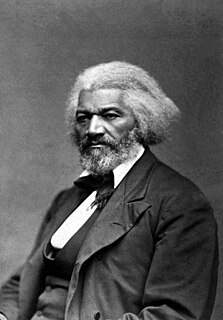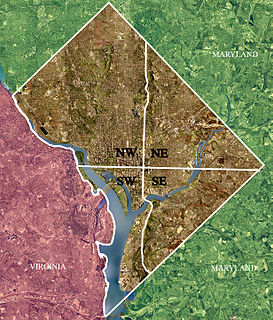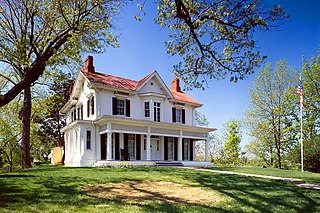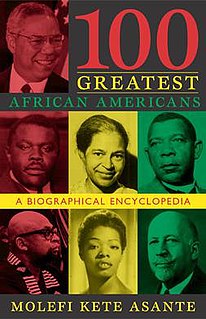
Frederick Douglass was an American social reformer, abolitionist, orator, writer, and statesman. After escaping from slavery in Maryland, he became a national leader of the abolitionist movement in Massachusetts and New York, gaining note for his oratory and incisive antislavery writings. In his time, he was described by abolitionists as a living counter-example to slaveholders' arguments that slaves lacked the intellectual capacity to function as independent American citizens. Northerners at the time found it hard to believe that such a great orator had once been a slave.
Edward White, Ed White, or Eddie White may refer to:

Northwest is the northwestern quadrant of Washington, D.C., the capital of the United States, and is located north of the National Mall and west of North Capitol Street. It is the largest of the four quadrants of the city, and it includes the central business district, the Federal Triangle, and the museums along the northern side of the National Mall, as well as many of the District's historic neighborhoods.

Narrative of the Life of Frederick Douglass is an 1845 memoir and treatise on abolition written by famous orator and former slave Frederick Douglass during his time in Lynn, Massachusetts. It is generally held to be the most famous of a number of narratives written by former slaves during the same period. In factual detail, the text describes the events of his life and is considered to be one of the most influential pieces of literature to fuel the abolitionist movement of the early 19th century in the United States.

The Frederick Douglass National Historic Site, administered by the National Park Service, is located at 1411 W Street, SE, in Anacostia, a neighborhood east of the Anacostia River in Southeast Washington, D.C.. Established in 1988 as a National Historic Site, the site preserves the home and estate of Frederick Douglass, one of the most prominent African Americans of the 19th century. Douglass lived in this house, which he named Cedar Hill, from 1877 until his death in 1895. Perched high on a hilltop, the site also offers a sweeping view of the U.S. Capitol and the Washington, D.C., skyline.

Neighborhoods in Washington, D.C., are distinguished by their history, culture, architecture, demographics, and geography. The names of 131 neighborhoods are unofficially defined by the D.C. Office of Planning. Neighborhoods can be defined by the boundaries of historic districts, Advisory Neighborhood Commissions, civic associations, and business improvement districts (BIDs); these boundaries will overlap.

The Frederick Douglass Memorial Bridge is a swing bridge that carries South Capitol Street over the Anacostia River in Washington, D.C. It was built in 1950 and named after abolitionist Frederick Douglass. In 2007, the bridge was used by 77,000 daily commuters.
Tench Ringgold was a businessman and political appointee in Washington, DC. He was U.S. marshal of the District of Columbia, appointed by President James Monroe (1817-1825) and serving in the position through 1830, during the first two years of the administration of Andrew Jackson. Ringgold also owned a leather factory and curing shop in Georgetown. He was appointed Treasurer of the Georgetown Savings Institution in what was then a separate jurisdiction later annexed by the District of Columbia.

Edward Douglass White Sr. was tenth Governor of Louisiana and a member of the United States House of Representatives. He served five non-consecutive terms in Congress, as an adherent of Henry Clay of Kentucky and the Whig Party.

The Emancipation Memorial, also known as the Freedman's Memorial or the Emancipation Group, and sometimes referred to as the "Lincoln Memorial" before the more prominent so-named memorial was built, is a monument in Lincoln Park in the Capitol Hill neighborhood of Washington, D.C.

100 Greatest African Americans is a biographical dictionary of one hundred historically great Black Americans, as assessed by Temple University professor Molefi Kete Asante in 2002.

The following outline is provided as an overview of and topical guide to Washington, D.C.:
The Public Menace is a 1935 American black-and-white romantic drama film starring Jean Arthur, George Murphy and Douglass Dumbrille. A newspaper reporter keeps losing and regaining his job due to a manicurist he is persuaded to marry.
End of the Trail is a 1936 American western film directed by Erle C. Kenton and starring Jack Holt, Louise Henry and Douglass Dumbrille.

Woman in Distress is a 1937 American crime film directed by Lynn Shores and written by Albert DeMond. The film stars May Robson, Irene Hervey, Dean Jagger, Douglass Dumbrille, George McKay and Gene Morgan. The film was released on January 17, 1937, by Columbia Pictures.

Frederick Douglass is a 2013 bronze sculpture depicting the American abolitionist and politician of the same name by Steven Weitzman, installed in the United States Capitol Visitor Center's Emancipation Hall, in Washington, D.C., as part of the National Statuary Hall Collection.














